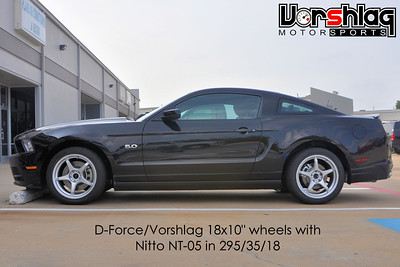My own set as well as all the sets of AST's I sold (and I'm sure Dave Lowum can vouch for this), had a sway bar bracket that was of a very similar design where it was a tab welded to a collar that was pinched onto the threaded portion of the strut. Also they did not have the angle build in either, so when the strut was in the car, there was a lot of angle on the upper end of the pivot of the sway bar link. We should be fair about pointing out things like this. IF AST has changed this, great and I'm glad to know it, but the original solution wasn't even that good. Now that I think about it, it was also not recessed to the rear of the strut, but actually was on the centerline of the strut when viewed from the front or back.

Yep, your set of AST 4100s was from at least 3 years ago? I thought you and AST divorced way back. The S197 sets have been revised since then, and the 4150 is completely different. I never liked adjustable stabar brackets and AST agrees - and they have moved on and don't use that anymore. Old news.

Notice the welded stabar bracket above - all of the new 4150 struts are built with fixed/welded stabar brackets now. We had them make a bunch of other updates and changes as well - the rear shock is a completely different unit than the old ones you sold (and I had them make our 4100s that way - gained 2.5" of bump travel). I'll post up more about these 4150s when they arrive later this week. We have the entire 2012 production run coming here.
As for the rates. 225/200, there or there about is not at all a weird setup (if it's front/rear and not the other way around) for a nice street setup. I'm not a huge fan of these for other reasons, but spring rate is not one. They are building a kit to make the most folks happy, they aren't building a hard core race kit. Even at that, there are those that compete and win using softer rates (though stiffer than this) than what others think is correct.
Let's look at some real data:
- Stock S197 Spring rates: 112 #/in Front, 160 #/in Rear (from my 2013 GT)
- Shelby Mustang S197: 300 #/in Front (this is mere rumor of course - there is zero real spring rate data out there for the M-5300-P springs. I guess nobody has a spring rater??)
- Starting point on our Vorshlag/AST set-up: 450F/175R
Why did they jack the front rates up and not the rears? Well to keep the nearly 56% front weight bias in check in brake dive/body roll. Keeping the stock front/rear spring rate biases only makes it handle more like the push-heavy stock suspension. Modified suspensions tend to move well away from stock front/rear spring rate biases. We always recommend upping the front rates much higher than the rears on S197s for this reason. And almost every GRAND AM and WC Mustang S197 race team agrees, as most of them run... 450F/175R. We've tested with softer front rates and the car starts flopping around like a dead fish. Jacking the rear rates up faster than the fronts kills the ride and corner exit traction. The ride goes to pot because a solid axle car like this has the rear springs working in parallel so they are additive in bump, therefore you need to double the rear rate for bump use (but not in roll). That 250#/in rear spring becomes 500#/in in bump... ride goes to crap in the hurry.
We don't get to 250#/in rear rates until we exceed 600#/in up front. Otherwise the balance is terrible. Of course this isn't how Sam likes to set up his cars, but it is how most racers set-up their cars. You can fake a little bit of that in bars. Again, this is just my opinion... but it is from running 50+ competition events and private tests in S197s with coilovers, trying dozens of spring set-ups. I let the clocks tell me when it is working better, not the internets.
Of course many dampers out there cannot deal with 450#/in rates, and the ride goes to crap anyway. The Chinese/Eibach level shocks probably don't have the valving sorted out any better than the many physical errors in the rest of those coilover kits.
I ran 18x10 and 18x10.5" fronts on my 5.0 when I ran ESP part time in 2011 with a good old set of Koni's on it. They didn't stick out at all, no trickery required, no custom wheels required. In fact my avatar is my 2011 5.0 on those 18x10.5's with 315 Hoosier's mounted on regular old Koni Sports.


I agree - an 18x10.5" can fit these cars. The problem is the commonly used Enkei 18x10.5" wheel that so many ESP racers with S197s use does fit in the front (see above) but.... it sticks out a lot when used on the back (see below).

I know because I bought that same wheel and tested with it. It was just... terrible. And as far as I can see that is the only 18x10.5" 1-piece wheel out right now, and it don't fit the back. You can get custom wheels made with differing front/rear offsets to fit these cars, of course, and if you want to push the limits you can go 12" rear under stock fenders, as we've shown. But an 18x10 ET43 wheel is about the only set-up that can fit front and rear without sticking out on either end.
What bothers me is the aversion, near phobia of using even an 18x10" wheel front and rear on these cars? I see so many track and autocross guys on forums fumbling around on little 8" and 9" wide wheels, or "staggered set-ups" on these very big, hugely FAT ASS Mustangs. Bizarre.... that's the number one performance improvement trick on the 3600+ pound S197: add as much wheel/tire as you can afford. 18x10" wheel and 295/35/18 tire should be the starting point for anyone with track or autocross pretensions. And they work fine on the street, too. My wife and I daily drive both of our track/autocross prepped S197 Mustangs on 18x10" wheels. Zero issues.


I dunno... it seems like we're going round and round and getting nowhere. Fixating on spring rates for low-end shocks is probably an enormous waste of time. Run them soft, go with 250F/200R, it won't make a whole lot of performance difference if you are on skinny little tires anyway.
Cheers,



